Progressive polycomb assembly on H3K27me3 compartments generates polycomb bodies with developmentally regulated motion
- PMID: 22275876
- PMCID: PMC3262012
- DOI: 10.1371/journal.pgen.1002465
Progressive polycomb assembly on H3K27me3 compartments generates polycomb bodies with developmentally regulated motion
Abstract
Polycomb group (PcG) proteins are conserved chromatin factors that maintain silencing of key developmental genes outside of their expression domains. Recent genome-wide analyses showed a Polycomb (PC) distribution with binding to discrete PcG response elements (PREs). Within the cell nucleus, PcG proteins localize in structures called PC bodies that contain PcG-silenced genes, and it has been recently shown that PREs form local and long-range spatial networks. Here, we studied the nuclear distribution of two PcG proteins, PC and Polyhomeotic (PH). Thanks to a combination of immunostaining, immuno-FISH, and live imaging of GFP fusion proteins, we could analyze the formation and the mobility of PC bodies during fly embryogenesis as well as compare their behavior to that of the condensed fraction of euchromatin. Immuno-FISH experiments show that PC bodies mainly correspond to 3D structural counterparts of the linear genomic domains identified in genome-wide studies. During early embryogenesis, PC and PH progressively accumulate within PC bodies, which form nuclear structures localized on distinct euchromatin domains containing histone H3 tri-methylated on K27. Time-lapse analysis indicates that two types of motion influence the displacement of PC bodies and chromatin domains containing H2Av-GFP. First, chromatin domains and PC bodies coordinately undergo long-range motions that may correspond to the movement of whole chromosome territories. Second, each PC body and chromatin domain has its own fast and highly constrained motion. In this motion regime, PC bodies move within volumes slightly larger than those of condensed chromatin domains. Moreover, both types of domains move within volumes much smaller than chromosome territories, strongly restricting their possibility of interaction with other nuclear structures. The fast motion of PC bodies and chromatin domains observed during early embryogenesis strongly decreases in late developmental stages, indicating a possible contribution of chromatin dynamics in the maintenance of stable gene silencing.
Conflict of interest statement
The authors have declared that no competing interests exist.
Figures
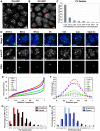
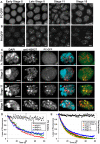

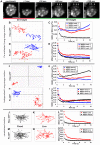
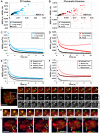

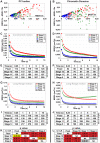
Similar articles
-
Chromosomal distribution of PcG proteins during Drosophila development.PLoS Biol. 2006 Jun;4(6):e170. doi: 10.1371/journal.pbio.0040170. Epub 2006 Apr 20. PLoS Biol. 2006. PMID: 16613483 Free PMC article.
-
Global changes of H3K27me3 domains and Polycomb group protein distribution in the absence of recruiters Spps or Pho.Proc Natl Acad Sci U S A. 2018 Feb 20;115(8):E1839-E1848. doi: 10.1073/pnas.1716299115. Epub 2018 Feb 5. Proc Natl Acad Sci U S A. 2018. PMID: 29432187 Free PMC article.
-
The enhancer of polycomb gene of Drosophila encodes a chromatin protein conserved in yeast and mammals.Development. 1998 Oct;125(20):4055-66. doi: 10.1242/dev.125.20.4055. Development. 1998. PMID: 9735366
-
The multiscale effects of polycomb mechanisms on 3D chromatin folding.Crit Rev Biochem Mol Biol. 2019 Oct;54(5):399-417. doi: 10.1080/10409238.2019.1679082. Epub 2019 Nov 7. Crit Rev Biochem Mol Biol. 2019. PMID: 31698957 Review.
-
Polycomb Recruiters Inside and Outside of the Repressed Domains.Int J Mol Sci. 2023 Jul 13;24(14):11394. doi: 10.3390/ijms241411394. Int J Mol Sci. 2023. PMID: 37511153 Free PMC article. Review.
Cited by
-
SALL1 Modulates CBX4 Stability, Nuclear Bodies, and Regulation of Target Genes.Front Cell Dev Biol. 2021 Sep 21;9:715868. doi: 10.3389/fcell.2021.715868. eCollection 2021. Front Cell Dev Biol. 2021. PMID: 34621739 Free PMC article.
-
A disordered linker in the Polycomb protein Polyhomeotic tunes phase separation and oligomerization.Mol Cell. 2025 Jun 5;85(11):2128-2146.e15. doi: 10.1016/j.molcel.2025.05.008. Epub 2025 May 28. Mol Cell. 2025. PMID: 40441156
-
Subnuclear positioning and interchromosomal clustering of the GAL1-10 locus are controlled by separable, interdependent mechanisms.Mol Biol Cell. 2016 Oct 1;27(19):2980-93. doi: 10.1091/mbc.E16-03-0174. Epub 2016 Aug 3. Mol Biol Cell. 2016. PMID: 27489341 Free PMC article.
-
Something silent this way forms: the functional organization of the repressive nuclear compartment.Annu Rev Cell Dev Biol. 2013;29:241-70. doi: 10.1146/annurev-cellbio-101512-122317. Epub 2013 Jul 5. Annu Rev Cell Dev Biol. 2013. PMID: 23834025 Free PMC article. Review.
-
A repetitive elements perspective in Polycomb epigenetics.Front Genet. 2012 Oct 8;3:199. doi: 10.3389/fgene.2012.00199. eCollection 2012. Front Genet. 2012. PMID: 23060903 Free PMC article.
References
-
- Jenuwein T, Allis CD. Translating the histone code. Science. 2001;293:1074–1080. - PubMed
-
- Shao Z, Raible F, Mollaaghababa R, Guyon JR, Wu CT, et al. Stabilization of chromatin structure by PRC1, a Polycomb complex. Cell. 1999;98:37–46. - PubMed
-
- Simon JA, Kingston RE. Mechanisms of Polycomb gene silencing: knowns and unknowns. Nat Rev Mol Cell Biol 2009 - PubMed
-
- Schwartz YB, Pirrotta V. Polycomb silencing mechanisms and the management of genomic programmes. Nat Rev Genet. 2007;8:9–22. - PubMed
-
- Schuettengruber B, Chourrout D, Vervoort M, Leblanc B, Cavalli G. Genome regulation by polycomb and trithorax proteins. Cell. 2007;128:735–745. - PubMed
Publication types
MeSH terms
Substances
Grants and funding
LinkOut - more resources
Full Text Sources
Molecular Biology Databases

